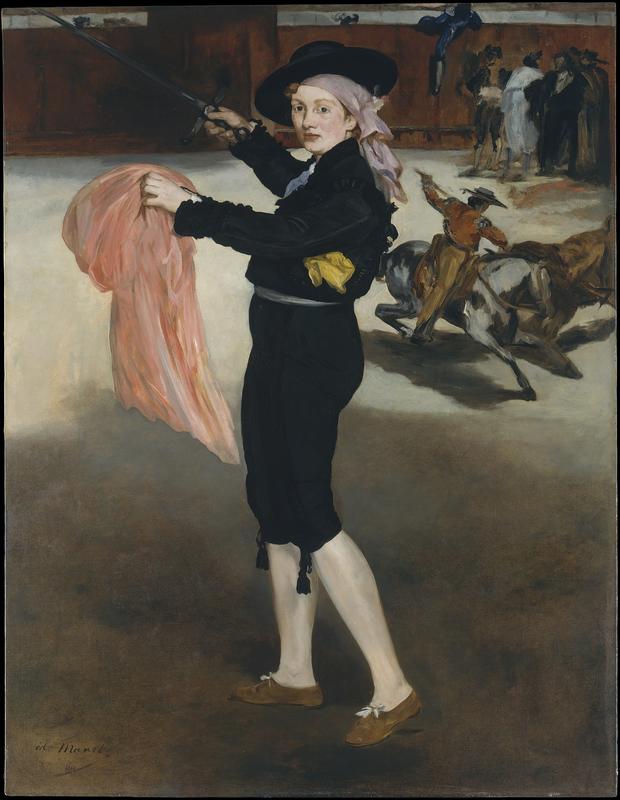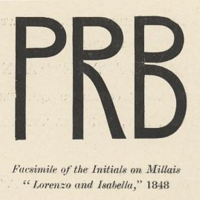More about Mademoiselle V. . . in the Costume of an Espada

Contributor
Wondering who that swish lady is rocking the androgynous duds? It’s Manet’s muse of choice – Victorine Meurent!
But wait a second…can it really be her? We’re so used to seeing her in the buff in works like Olympia and Dejeuner sur l’Herbe, that she’s barely recognizable fully clothed! And it’s no wonder that this work isn’t as famous or as controversial…sex sells, people. That’s the sad, art historical truth. Anyway, La Crevette aka the Shrimp aka Victorine is living up to her nickname over here. She looks way slighter in men’s clothing than she does in the nude. And not just any old men’s outfit, but a matador’s costume. Though she’s added some personal touches to the look, with slightly more unpractical shoes and a pink cape that’s not quite the right shade of fuchsia for the sport.
Still, Victorine carries off the look with confidence, which is surprising because she’s always seemed like such a wallflower in Manet’s work (psych!). But this female espada isn’t the only subject of this painting. There’s some other folks in the background carrying on with their bullfighter-ly duties. But a shout out needs to be given to Goya for this image’s background elements, because the backdrop is actually appropriated from one of Goya’s paintings. The Spaniard had painted a series under the title of Tauromaquia, which was all about giving props to matadors. This obvious inspiration from Goya lead 19th century critics to believe that Manet was totally stoked on Goya and was possibly even his favourite master. In fact, this painting of Manet started out as an etching…which, hello, was also one of Goya’s favourite mediums!
But the painting is still classically Manet, with the presence of Victorine and the weird out-of-perspective background peeps. If you take a look at Luncheon on the Grass, you’ll notice how the lady in the background is not entirely proportionate to the figures in the foreground. SAME PROBLEM in this painting. Look at how bullfighter/horseman in the immediate background is suspended in a weird space…that means you can’t clearly tell how far away he is. Considering how small he is in proportion to Victorine, there ought to be a lot more space between them. Clearly, Manet couldn’t be bothered when it came to painting the extras in his paintings.

Contributor
Star model Victorine Meurent takes the stage in Mademoiselle V. In the Costume of an Espada, a work that probably got eye rolls from authentic matadors.
Unfortunately, Meurent and Manet didn’t get the kind of bullfighting experience they needed to pull this one off in their Paris art studios. The details are obviously phony, from Meurent’s shoes and pink cape to her sword pointed skyward. Did Manet, always cheeky and deliberately inflammatory, purposefully goad his crowd with errors? Or did he make careless mistakes, failing to research matadors beyond a cursory glance at a couple Goya paintings?
Luckily for Manet, all mistakes are automatically voided by the inclusion of model Victorine Meurent, glorious star of Luncheon on the Grass. Queen of not giving a rat’s ass about the era’s oppressive standards of propriety, Meurent hasn’t received the recognition she deserves in history books. An artist herself, Meurent’s works were repeatedly shown in the Salon. Still, she became infamous for her nude modeling for works like Olympia, and labeled a prostitute. Her naked profile in Luncheon on the Grass so offended its audience that multiple viewers bashed the tableau with a stick.
Poor Meurent’s reputation couldn’t catch a break, even after her death. A Manet biography labeled her a drunkard, describing her as a prostitute who wasted away in the shadows. In reality, Meurent was an independent artist who lived to 83. All these rumors, born because the poor woman flashed a buttock or two on canvas. Give Victorine the credit she deserves!
Meurent even refused compensation from Manet for her contributions, only writing to his widow for the promised cash years later, when times were especially tough. Her request was ignored. Suzanne Manet was a bit of a shady lady, after all. Historians debate whether her son Léon-Edouard’s father was Manet himself or Manet’s father Auguste. Family reunions must have been a blast.
In light of suspicious widows and slut-shaming audiences, it’s good to see Victorine having fun for once. Even so, we see straight through the matador costume. Don’t try this at home, unless your dream is to be trampled by an enraged bull.
Sources
- “Mademoiselle V… In the Costume of an Espada.” The Met. Accessed June 12, 2017. http://www.metmuseum.org/art/collection/search/436945.
- Meyers, Jeffrey. Impressionist Quartet: The Intimate Genius of Manet and Morisot, Degas and Cassat. Harpenden: Southbank Publishing, 2016. Accessed June 11, 2017. https://books.google.com/books?id=amDoDQAAQBAJ&lpg=PT35&dq=manet%20vict…
- “Victorine Meurent.” Wikipedia. March 18, 2017. Accessed June 12, 2017. https://en.wikipedia.org/wiki/Victorine_Meurent.
- Main, V.R. “The Naked Truth.” The Guardian. October 2, 2008. Accessed June 12, 2017. https://www.theguardian.com/lifeandstyle/2008/oct/03/women.manet.
- Davies, Serena. “Did Manet have a secret son?” The Telegraph. January 18, 2013. Accessed June 12, 2017. http://www.telegraph.co.uk/culture/art/art-features/9796322/Did-Manet-h….
Featured Content
Here is what Wikipedia says about Mademoiselle V. in the Costume of an Espada
Mademoiselle V. in the Costume of an Espada is an 1862 oil-on-canvas painting by French artist Édouard Manet. The painting is in the collection of the Metropolitan Museum of Art, having been acquired in 1929. Manet exhibited the painting at the 1863 Salon des Refusés alongside Jeune Homme en costume de majo and Le Déjeuner sur l'herbe. It is often cited as an example of Manet's work being influenced by Spanish art.
Check out the full Wikipedia article about Mademoiselle V. in the Costume of an Espada
















